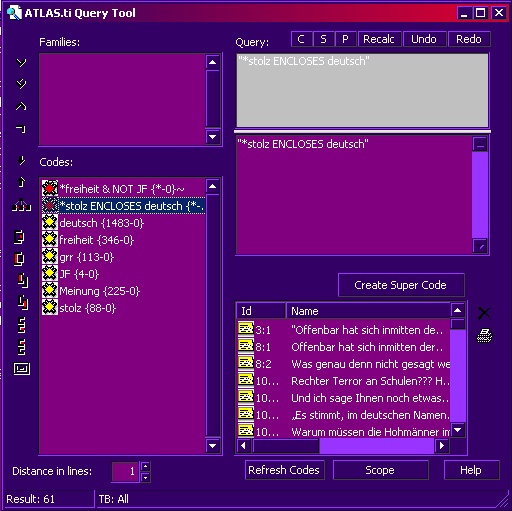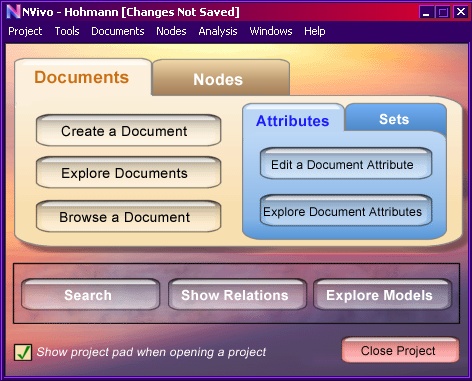There are at least three reasons, why you should seriously consider the intelligibility and user friendliness of software:
- Your learning curve of a program depends at least partially on the question of the intelligibility of its user interface. That kind of userfriendliness depends on the clarity of its menu structure, your familiarity with its overall structure and the intelligibility of its graphics. The former will depend on your familiarity with its graphical outlook, i.e. for most contemporary users the interface should resemble modern Windows programs, while the latter will depend on the choice of icons and their textual description.
- The biggest advantage of computer-assisted content analysis is its capability to handle bulk data. If you want to handle large amounts of data with some interpretive input by the analyst, then a fast handling of the interface is essential. Therefore, customizable keystroke commands would be desirable for efficient data handling.
- Finally, the easier intelligible a program is, the more likely it is that you will know all of its options, as most people do not tend to read through the manual.
Unfortunately, almost all contemporary CAQDAS do not behave like modern Windows programs, but their window design and handling is frequently oriented at outdated versions of Windows.
Except for N6, which features an archaic Windows 2 style interface, which pastes command lines into a window, all programs are highly mouse oriented, excluding less intuitive, but faster keystroke commands.
For Windows users, it might be at first confusing that HyperRESEARCH even in its Windows version behaves like an apple program, even emulating characteristic Apple sounds. HyperRESEARCH windows are also the most difficult to handle in Windows, because they again behave like Apple windows and open four main Windows windows instead of a variety of subwindows, as most indigenous Windows programs do.
ATLAS.ti, whose search window (shown below) contains buttons labeled with a single letter and whose default layout clutters its interface with a button, whose sole function is the production of a computer voice proclaiming "I hate computers" does certainly not deliver a groundbreaking interface with respect to ease of use. Thankfully, from Built 62 onwards, this button can be removed by checking the option "be serious" in the preferences menu.

The main menu of NVivo does not offer the familiar structure of drop down menus on, but instead offers a "Project Pad" (pictured below), which contains several buttons on several nested tabs.

MAXqda, QDA Miner and Qualrus follow the normal layout of Windows programs most closely. The latter two programs also offer the easiest window handling.
| Interface "Feel" |
Icons | Window Handling1 |
Shortcut Keys |
|
|---|---|---|---|---|
| ATLAS.ti 5.0 | Windows 95 | cryptic | non-standard (drop down menus), no shortcut keys | very few, not customizable |
| E6 | Windows 95 | … | … | … |
| HyperRESEARCH 2.6 | Mac-OS | text menus only | non-standard: several floating windows, non-standard shortcut keys: windows appear as if four differerent applications | none |
| Kwalitan 5.09 | Windows 3.11 | next to verbal explanation, some menus not translated from Dutch | Windows 3.11 behavior, no shortcut keys | none |
| MAXqda 2 | Windows 3.11 | fairly intuitive, tooltip pop-ups | Windows 3.11 behavior, no shortcut keys | none |
| N6 | Windows 2.0 upon DOS commands | none | n/a | none |
| NVivo 2 | non-standard, Windows 95 | fairly intuitive | … | none |
| QDA Miner 1.0.15 | Windows 95 | intuitive | non-standard | none |
| Qualrus 2.0.4.0 | Windows 95 | mainly text buttons | no shortcut keys | very few; for text editing only |
| TAMS 2.50b5 | Mac-OS | … | … | … |
| Non-CAQDAS benchmark programs | ||||
| InfoRapid Search&Replace 3.1e | Windows 3.11 | none | n/a | n/a |
| Transana 1.22 | X-Windows | text menus only | unwieldy | none |
